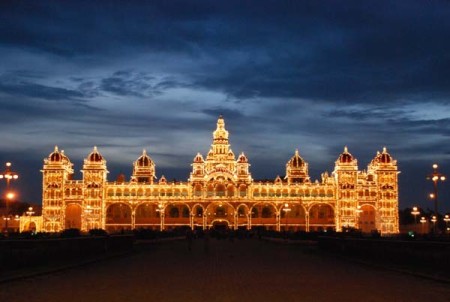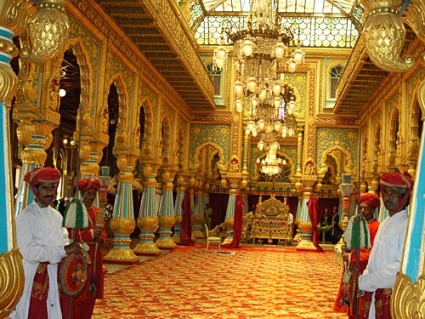Mysore Palace centre for Dasara Celebrations
Mysore Palace History:
Mysore is famous for its historic palaces, also called the City of Palaces. Mysore Palace is renowned among the courts and has a rich history. The court was commissioned in 1897, and the construction was completed in 1912. It has two durbar halls. Now court lace is one of the most attractive tourist palaces in India. However, tourists do not always visit the court to take photographs inside the castle lake.

Mysore Palace Architecture:
The palace’s architectural style combines Indo-Saracenic, Hindu, Muslim, Rajput and Gothic styles. The Mysore palace was constructed on a three-storied farm with grey granite stones and five-storey towers 145 ft high built with white marble. A beautiful garden spread around the court. There is an impressive sculpture of the Goddess of wealth and prosperity, Gajalakshmi, situated above the central arch and in abundance with her elephants. The Wadiyar dynasty constructed a palace and ruled Mysore for nearly six centuries from the 14th century onwards.
Wadiyar Dynasty and Its Origin:
There was a story behind the origin of the Wadayar dynasty. Two young men, Vijaya and Krishna of the Yadu dynasty hailing from Dwaraka, came to Mysore on their pilgrimage. They visited the Kodi Byraveswara Temple and took shelter under a; in those days, Mysuru was a small city, and the people fetched waiting from the Doddakere village lake. Then both princes heard two women discussing the distressed situation of the young Princess Devajammanni. Her father’s death caused an advantageous position for the chief of Karugahalli, Maranayaka, who began demanding the kingdom and the princess in marriage.
Princes Helps to Jangama Odeya:
After listening to the s, the two young men wanted to help the pain, so they took the help of a Jangama Odeya, a Shaivite religion. They killed the Karugahalli Chief and his men and saved the Mysore royal family and their kingdom. Then the young princess felt very happy with the help of the two brothers and married the elder brother Vi, Jaya, and he became the first ruler of the Yadu dynasty. On the way, the Wadiyar dynasty formed in the year 1399 AD. Since then, 24 rulers have succeeded in the dynasty. The last ruler was Jayachamaraja Wad; during his time, Ingrained became independent once, and the last monarchy was abolished.
Dasara Celebrations in Mysore Palace:

The Mysore palace was very famous for celebrating the Mysuru Dasara festival. The festival celebrates for ten days with great pomp and attracts tourists from all over the world. The tradition of Dasara celebrations started in 1610 AD by the Wadiyars. On the festival day, a stage is set up on the palace grounds, and the artists perform their skills like dancing, singing, and other mythological scripts and attract the spectators.
On Dasara Day:
On the tenth day of Vijaya Dashami, a parade starts from the palace with beautified elephants, artists, singers, dancers and other cultural performers; it seems very colourful and bright looking and shows the culture of Hinduism. And the festivities have become an integral part of Mysore cultural activities. During the festival celebrations, Mysore Palace is illuminated with more than 96,000 lights and decorated in a wide range. The festival celebrates in October of each year. The festival symbolized the triumph of good over evil according to Hindu mythology called Mahishashura Mardini. This means Goddess Durga slew the demon Mahishasura on the day of Dasara.
About the Durbar Hall in Mysore Palace:
Public Durbar Hallmassivehuge . When tourists enter the Durbar Hall, we can see the life-size statue of Krishnaraja Wadiyar IV. And near him is the cut-out photograph of his servant Jamedar Bait. The Hall was decorated with French lamp stands and Egyptian figurines. The floor is covered with fantastic marble, and the walls are decorated with hanging paintings of images of Gods, portraits of royal families and scenes from the great epic the Ramayana. The Kings host the meetings with the ministers from here only.
Private Durbar or Ambavilasa Palace.
Private Darbar in Mysore Palace:
Mysore palace carved rosewood doorway inlaid with ivory that opens into a shrine to Ganesha. The rooms are most spectacular. The king used this palace for a private audience. These rooms are decorated with steel grills, chandeliers, and motifs mirrored in the pietra dura mosaic floor.
Gombe Thotti (Doll’s Pavilion):
This Pavilion is at the entry of the Mysore palace. Many collected traditional dolls are decorated in this Pavilion.

Kalyana Mantapam in Mysore Palace:
Kalyana Mantapam celebrates all royal weddings, birthdays and ceremonial functions. It is shaped like an Octagonal, and pillars support the dome. Around the wedding hall 26, Dasara procession paintings hung. The four subject paintings are the birthday procession of Krishnaraj Wadiyar IV, Durga Pooja, the car festival of Goddess Chamundeshwari and the celebrations of Krishna Janmashtami.
Portrait Gallery in Mysore Palace:
The southern part of the Kalyana mandapa also contains a portrait Gallery. The portrait and photographs of the Royal family are exhibited in this gallery. The black and white wedding images of Jayacharamajra Wadiyar are also shown in this gallery.
Temples inside Mysore Palace Fort:
Kodi Bharravasvami Temple – In the temple, Lord Shiva is in the form of Bhairava.
Sri Lakshmiramana Swami Temple – This temple is located towards the western part of the fort and is the oldest temple in the city. All religious ceremonies were held in the temple, and Raja Krishnaraj Wadiyar III’s coronation was also held on June 30, 1799.
Sri Shweta Varahaswamy Temple – This temple was constructed in the style of the great Hoysala Empire and is located beside the south gate of the palace.
Sri Trinayaneshvara Swami Temple – Ancient temple located on the bank of Devaraya Sagara outside the fort. During the time of Kanthirava Narasaraja Wadiyar and his successor Dodda Devaraja Wadiyar, the fortress was enlarged, and the Trinayaneshvara temple came within the defence.
Other Temples:

Kille Venkatramana Swamy Temple – During the time of Tipu, the Wadiyar family deeply worried about the dynasty and its future. One night Queen Lakshmammanni, wife of Krishnaraja Wadiyar, got a dream; in the plan, Lord Venkataramana appeared and directed her that his statue, which is in Balamuri, should be consecrated in Mysore. By doing this righteous act, the kingdom was restored to the Wadiyar dynasty.
Sri Bhuvaneshwari Temple – Sri Jayachamarajendra Wadiyar constructed this temple in 1951. The temple is located on the northern side of the Palace Fort.
Sri Gayatri Temple – Jayachamarajendra Wadiyar constructed this temple in 1953. The temple is located in the southeast corner of the fort. There are three shrines dedicated to Savithri, Gayathri, and Saraswathi.